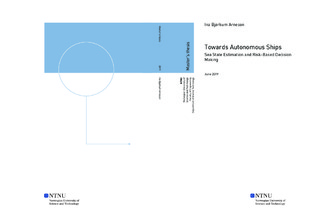| dc.contributor.advisor | Sørensen, Asgeir J. | |
| dc.contributor.advisor | Utne, Ingrid B. | |
| dc.contributor.author | Arneson, Ina Bjørkum | |
| dc.date.accessioned | 2019-10-17T14:08:46Z | |
| dc.date.available | 2019-10-17T14:08:46Z | |
| dc.date.issued | 2019 | |
| dc.identifier.uri | http://hdl.handle.net/11250/2622951 | |
| dc.description.abstract | Hovedtemaet i denne masteroppgaven er situasjonsforståelse. Oppgaven er todelt, hvor første del handler om sjøtilstandsestimering for et dynamisk posisjonert (DP) fartøy, og andre del handler om risikobaserte beslutninger for å unngå kollisjon for et autonomt DP fartøy. Begge temaene er i høy grad relatert til forskning om autonome skip, da sjøtilstand er en viktig input til et autonomt beslutningssystem.
En algoritme for sjøtilstandsestimering som er uavhengig av transferfunksjonene til skipet har blitt utviklet for et fartøy i DP. Algoritmen bruker Kvadratisk Diskriminant Analyse til å estimere den absolutte bølgeretningen, og estimerer videreombølgenkommerfrastyrbordellerbabordvedbrukavhiv-rullkrysspekteret. Når det er relevant, skiller algoritmen mellom motsjø og medsjø. Videre bruker algoritmen Partial Least Squares Regression for å estimere signifikant bølgehøyde og bølgeperiode. Algoritmen trenes på et simulert datasett for NTNUs forskningsbåt RV Gunnerus, oger validert på data som ikke var i treningsdataen. Resultater har vært lovende, og sammenlignbare med modellbaserte metoder med samme mål.
En online beslutningsmodell har også blitt laget. Modellen bruker et Bayesiansk nettverk som dekker en rekke faktorer som kan påvirke kollisjonsrisiko for et autonomt skip. Modellen tar beslutninger basert på situasjonen og kollisjonsrisiko påetgitttidspunkt. Forskjelligesituasjonerharblitttestetimodelleksperimenter, hvor systemet tok riktige beslutninger og handlet basert på situasjonen. Modellenerengodrepresentasjonpåenonlineogautonommetodesombrukerrisiko som kriterie for å ta en beslutning, og kan bli utviklet videre til å inkludere flere situasjoner og utfall. | |
| dc.description.abstract | The overall topic of this thesis is situation awareness in autonomous systems. The thesis is divided into two parts, where the first is related to estimating the sea state of a dynamically positioned (DP) vessel, and the second is about decision-making related to collision risk for a DP vessel. These topics are highly relevant for research on autonomous ships, as the sea state is a crucial input to an autonomous decision system.
A sea state estimation algorithm independent of the vessel transfer function has been developed for a vessel in DP. The algorithm uses Quadratic Discriminant Analysis for estimating the absolute wave direction, and further uses the heave-roll cross spectrum to estimate whether waves are incoming from port or starboard. When relevant, the algorithm also distinguishes between head and following sea. Further, Partial Least Squares Regression is used to estimate the significant wave height and the peak wave period. The algorithm is trained on a simulated dataset for NTNU's Research Vessel Gunnerus, and validated on a dataset with sea states not present in the training data. Results have been promising, and comparable to model-based methods with the same objective.
An online decision model has also been established. The model uses a Bayesian Belief Network which covers a range of factors which can affect the risk of collision for an autonomous ship. The model makes decisions based on the scenario/events present and the risk of collision at a point in time. Different scenarios have been tested in model experiments, where the system has shown to make the right decisions and take actions based on the scenario in question. The model is a good representation of an online and autonomous method using risk as the decision criteria, and can be further developed to include more scenarios and possible outcomes. | |
| dc.language | eng | |
| dc.publisher | NTNU | |
| dc.title | Towards Autonomous Ships | |
| dc.type | Master thesis | |
